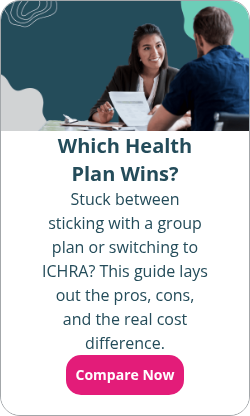Is our organization’s health coverage considered minimum value?
By Holly Bengfort on April 30, 2024 at 7:05 AM
If you’re an employer with 50 or more full-time equivalent employees (FTEs), the federal government considers you an applicable large employer (ALE). As a result, you must follow specific requirements set forth by the IRS and the Affordable Care Act (ACA).
One of these requirements is offering health coverage that meets minimum value (MV) to full-time employees. That leaves ALEs with two big questions: Which health plans are considered minimum value? And how do you know if the one you're offering meets that requirement?
This article has everything you need to know to determine if your health insurance plan meets the guidelines for minimum value, the penalties you may face if you don't offer proper coverage, and alternatives to a traditional employer-sponsored group plan that still meet minimum value.
Takeaways from this blog post:
- If an employer-sponsored plan covers at least 60% of the total costs of medical services, including physician services and inpatient care, the ACA considers it to offer minimum value.
- Employers who don’t provide health insurance plans with minimum value to their employees may face fines for not complying with standards.
- Employers interested in affordable health coverage can use the individual coverage HRA (ICHRA) or the group coverage HRA (GCHRA) to meet minimum value standards.
What is minimum value?
Minimum value is a standard for measuring job-based coverage to ensure it provides at least the minimum coverage mandated by the employer-shared responsibility provisions (ESRP) of the ACA.
Employer-provided health coverage meets minimum value if both of these situations apply:
- The plan pays at least 60% of the total cost of medical services for the standard population.
- The plan benefits include substantial coverage of physician services and inpatient hospital services.
Differences between minimum value and minimum essential coverage
While they sound similar, minimum value differs from minimum essential coverage (MEC). They're two different concepts in health insurance that the ACA introduced. MEC refers to any health insurance coverage that meets the individual shared responsibility requirement, also known as the individual mandate. Although the federal tax penalty for not having MEC no longer applies to individuals, it’s important that employers provide health coverage that offers MEC to their employees.
In order to avoid ESRP penalties as an ALE, your health plan must meet minimum value and affordability standards.
How do I know if my health coverage offers minimum value?
Generally, if you provide an employer-sponsored plan that covers at least 60% of the total costs of what's covered under the plan—including physician services and inpatient care—then your policy meets MV standards1.
If you're unsure if your plan meets this requirement, you'll need to run some calculations to see if it's compliant.
The easiest way to determine if your health coverage offers minimum value is by using the Department of Health and Human Services' minimum value calculator2. To calculate minimum value, you simply enter the information the calculator requests about your plan, such as its deductibles and copays. It will tell you whether or not your plan provides minimum value.
However, if you'd rather do the calculations manually, you can determine the MV percentage by dividing the cost of benefits the plan would pay for by the cost of benefits for “the standard population.” This includes the amount the plan pays and the amount the employee pays through cost-sharing. Then, you'll convert that number into a percentage.
What happens if I don't provide a plan with minimum value?
If you're an ALE who doesn't provide compliant health insurance policies to your employees, you may have to pay a fine for not complying with MV standards.
If an ALE provides coverage that doesn't meet affordability or MV standards and their employees end up turning down their employer-sponsored coverage and getting subsidized coverage through the marketplace, the employer may receive a fine of $4,460 per employee that's getting subsidized coverage.
If an ALE doesn't offer any coverage at all, they may receive a fine of $2,970 per employee per year (minus the first 30 employees).
Does a health reimbursement arrangement meet minimum value standards?
If you're interested in reimbursing your employees for their individual health insurance premiums and other medical services and expenses through a health reimbursement arrangement (HRA), there are a couple of options that meet minimum value standards.
Individual coverage HRA (ICHRA)
Whether you want to offer an HRA as a stand-alone benefit or as an option for your employees who don't qualify for an employer-sponsored group plan, an individual coverage HRA (ICHRA) is a great option that can meet the minimum value standard and help your employees better control their medical spending.
Through an ICHRA, your employees purchase their own qualifying individual health insurance and other medical care, and then you reimburse them tax-free up to a monthly allowance amount of your choosing. Since the ICHRA has no annual limits on contributions, you can offer as much or as little as you want. Reimbursable expenses include individual monthly premiums and other qualified out-of-pocket expenses.
As a general rule, ICHRAs use the lowest-priced silver benchmark plan on the health insurance marketplace as a benchmark for determining whether the ICHRA is affordable and has minimum value coverage. Silver plans provide coverage that exceeds minimum value, so the IRS considers ICHRAs that cover the cost of a silver plan as plans that meet minimum value for its participants.
Group coverage HRA (GCHRA)
If you currently have an employer-sponsored plan but want to supplement it with an HRA, a group coverage HRA (GCHRA), also known as an integrated HRA, is a perfect choice. While most traditional group plans easily meet MV standards, they don't always cover all your employees' healthcare necessities.
By combining employer-sponsored coverage with a GCHRA, your plan can meet MV standards. Employees get tax-free reimbursements on their out-of-pocket costs that your employer-sponsored plan doesn’t cover. However, unlike an ICHRA, you can’t reimburse individuals eligible for a GCHRA for their monthly premiums.
While many integrated HRAs are carrier-specific, PeopleKeep offers an integrated HRA that you can combine with any employer-sponsored health plan. Your staff will have the flexibility to choose the group health plan and medical care that best meet their needs.
Conclusion
When it comes to employer-sponsored coverage, not all job-based health plans are created equal. Choosing a qualified health plan that meets minimum value (MV) is essential for ALEs to stay compliant and attract and retain employees seeking meaningful coverage from their employer-sponsored plan.
If you think a health reimbursement arrangement is the health benefit that's right for your organization, then you're in luck. Schedule a call with our personalized benefit advisors, and we'll get you set up with everything you need to offer a customized HRA to your employees.
This article was originally published on May 10, 2021. It was last updated on April 30, 2024.
Check out more resources
See these related articles

What is a field marketing organization (FMO)?
This article breaks down what field marketing organizations (FMOs) are, how they work, and how they help insurance agents and brokers grow their businesses.

Is an integrated HRA right for my organization?
Wondering if your organization should implement an integrated HRA? This guide breaks down the rules and regulations to help you make an educated choice.

What is an exclusive provider organization (EPO) plan?
An exclusive provider organization (EPO) plan is a type of health insurance that offers a network of healthcare providers. Find out more about EPO plans.



